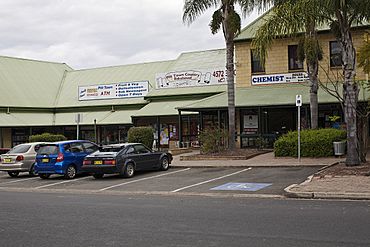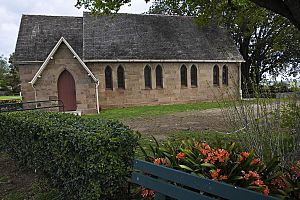Pitt Town, New South Wales facts for kids
Quick facts for kids Pitt TownNew South Wales |
|||||||||||||||
|---|---|---|---|---|---|---|---|---|---|---|---|---|---|---|---|

Pitt Town Shopping Mall
|
|||||||||||||||
| Population | 3,871 (2021 census) | ||||||||||||||
| Established | 1810 | ||||||||||||||
| Postcode(s) | 2756 | ||||||||||||||
| Elevation | 17 m (56 ft) | ||||||||||||||
| Location |
|
||||||||||||||
| LGA(s) | City of Hawkesbury | ||||||||||||||
| State electorate(s) | Hawkesbury | ||||||||||||||
| Federal Division(s) | Macquarie | ||||||||||||||
|
|||||||||||||||
Pitt Town is a historical town and suburb of Sydney, in New South Wales, Australia. It is about 59 kilometres north-west of the main Sydney city area. Pitt Town is part of the City of Hawkesbury local government area. The Hawkesbury River forms its northern border.
Contents
History of Pitt Town
Early Settlement and Naming
European settlement in Pitt Town started in 1791. Governor Arthur Phillip visited the area then. Land grants were given out along the river in 1792. One of the first landowners was James Ruse.
Pitt Town is one of the five "Macquarie Towns" created by Governor Macquarie in 1810. It was named after William Pitt the Younger. He was a British Prime Minister in the 1700s. He helped plan the start of New South Wales as a place for convicts.
The town was first planned in 1811. But it grew slowly because it was far from the river farms. So, Governor Macquarie moved the town to its current spot in 1815. By 1841, Pitt Town still had only 36 houses. Farmers had to travel far to their fields.
Street Names and Early Innovations
Many street names in Pitt Town are from the British government of 1808. These include Eldon, Grenville, Bathurst, Liverpool, Buckingham, Chatham, and Chandos Streets. Chandos Street is now Church Street.
Electricity came to Pitt Town in 1935. Town water supply arrived in the early 1940s. A large water tower in Hall Street provided water until 2019.
Pitt Town was also a place of firsts in farming. Lawrence May, an early settler, used irrigation here. This was the first time it was used for crops in Australia. May also built the first windmill in Pitt Town to make flour.
River Connection and Farming Changes
The town has always had a strong link to the Hawkesbury River. John Grono built many boats here in the early 1800s. A ferry service ran from Pitt Town to Wilberforce until the 1920s. The bell from the original ferry is now in the Hawkesbury Regional Museum.
For most of the 1800s, Pitt Town was a quiet farming community. Farmers grew lots of maize, grain, and corn. By the 1900s, citrus fruits like oranges became the main crop. But when cheaper oranges came from other countries, local demand dropped. Many farmers removed their orange groves. Since 2010, the area has been changing into a residential suburb.
Modern Developments and Community Spirit
The Pitt Town Shopping Centre was built in 1987. The old Bird in Hand Inn became a public inn. Before that, it was a general store called Millers Store for most of the 1900s. The original store was built in 1825. The current building was put up in the mid-1840s. The shopping area was made bigger in 2006.
During the 1940s, a second airstrip was built in Pitt Town. This was to help the Royal Australian Air Force base during World War II. Decoy planes and buildings were set up to trick enemies. After the war, the airstrip became a race track for testing car brakes. It was used until the mid-1960s. Today, it is a public road called 'Airstrip Road'.
In the 1980s, there were ideas to build Sydney's second international airport in Pitt Town. This would have meant the town would disappear. There was also a plan to turn a nearby army camp into a high-security prison. These ideas led to the creation of the Pitt Town Preservation Society. This group worked to protect the town's history.
In 1915, Pitt Town celebrated 100 years since its relocation. In 2015, it celebrated 200 years. A parade was held in 2010 to mark 200 years of the Macquarie Towns.
Architecture and Heritage
Historic Buildings and Churches
Pitt Town has two churches that face each other on Bathurst Street.
- St James Anglican Church: This Anglican church was designed by Edmund Blacket. It was built in 1857–58. It is in the Victorian Gothic Revival style. This style was common for religious buildings back then.
- The Scots Church: This church is simpler than St James. It was built in 1862. It is also in the Gothic Revival style.
There are also two cemeteries in Pitt Town. The Pitt Town General Cemetery is on Old Stock Route Road. The Pitt Town (St James) Anglican Cemetery is on Old Pitt Town Road. Many of Pitt Town's early settlers are buried there.
Heritage-Listed Sites
Pitt Town has many places listed for their historical importance. These are called "heritage-listed" sites. They show how old and important the area's history is.
Some key heritage sites include:
- Macquarie Arms Inn: Located at 104-106 Bathurst Street.
- Bird In The Hand Inn: Located at 87 Eldon Street.
- Old Houses: At 120 and 126 Bathurst Street, there are old wooden houses from the late 1800s. At 132 Bathurst Street, there are very old slab cottages.
- Bona Vista: This house on Johnston Street was built in 1888. It used to have a large garden, but now new houses have been built around it.
- The Manse: This building is at the northern end of Bathurst Street. It belonged to the oldest Presbyterian Church in Australia, which is across the river at Ebenezer. This shows that the river connected, rather than divided, early communities.
People of Pitt Town
Population Growth
Pitt Town is a growing suburb in the north-west of Greater Western Sydney. In 2006, about 1,311 people lived here. By 2016, the population grew to 3,033. This means the population more than doubled in 10 years! By 2021, it reached 3,871 people.
This growth is happening because of new housing developments. Pitt Town is also close to Sydney's North West Growth Area.
Who Lives Here?
Most people in Pitt Town have an Australian or English background. Many are Anglican or Catholic. The main language spoken is English. A small number of people speak Maltese (0.8%) or Italian (0.5%). Most (92.2%) people in Pitt Town speak only English at home.
Income and Homes
The people of Pitt Town have seen their income grow. In 2006, the average weekly household income was $1,265. By 2016, it was $2,316 per week. This shows a big increase in wealth.
Pitt Town is known as one of Sydney's "million-dollar suburbs." This means the average house price is over a million dollars. Most homes in Pitt Town are separate houses (95.9%).
Education
Local Schools
Pitt Town Public School is on Buckingham Street. It is a primary school for children. This is the fourth schoolhouse in Pitt Town's history.
The very first school was built around 1814. It was near the current Anglican church cemetery. It was an Anglican school. In 1820, the government bought a house to use as a temporary chapel and school. In 1827, a brick schoolhouse was built. This site later became the Pitt Town Anglican Church.
In 1876, a new school was built on Buckingham Street. It opened in 1878 as the first government school in Pitt Town.
Other schools nearby include Arndell Anglican College in Oakville and Windsor High School in Windsor.
Pitt Town in Pop Culture
A Country Practice
In 1981, Pitt Town became famous across Australia and beyond. It was used as the setting for "Wandin Valley" in the popular TV show A Country Practice. This show ran from 1981 to 1993.
Many outdoor scenes for the show were filmed in Pitt Town. For example:
- The heritage house opposite Pitt Town Public School was the home of characters Frank and Shirley Gilroy.
- The hardware store on the corner of Bathurst, Eldon, and Grenville Streets was called "Muldoon's Store."
- The Bird in Hand Inn was known as the "Wandin Valley General Store."
- Other private homes on Bathurst Street and Eldon Street were used for characters like Matron Maggie Sloan and Esme Watson.
The show also used other buildings in the Hawkesbury area. These included a hospital in Oakville and a doctor's surgery in Windsor. When the show moved to a different TV channel in 1994, filming moved to Emerald, Victoria.



